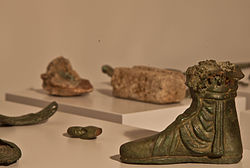

The calceus (pl.: calcei) was the common upper-class male footwear of the Roman Republic and Empire. Normally made of leather and hobnailed, it was flat soled and typically reached the lower shin, entirely covering the foot and ankle. It was secured with crossed thongs or laces. Equivalent to a short boot or high-top shoe, it was lighter than the military caliga but sturdier than slip-on shoes like the soccus and able to easily handle outdoor use.


